ARLINGTON: On Black Friday, you can line up at dawn for microwaves, wrestle strangers over sweaters, or kick the tires of cars you can’t afford. But how can you check out multi-million dollar war machines that may not even be built yet? With VR headsets, video theaters, and massive models. At least, you can at Bell Textron’s shiny new showroom, opened last year just a few minutes from the Pentagon.
“Where we’re at is called the Advanced Vertical Lift Center for Bell Textron,” Jeffrey Schloesser told me. A retired Army two-star general, he once commanded the 101st Airborne Division, later ran Army aviation, and is now Executive Vice President, Strategic Pursuits, for Bell, which has built helicopters for decades and now produces the famed V-22 Osprey tiltrotor.
The AVLC, as the staff of 13 who work there call it, is on the 10th floor of a building in Crystal City, an outcropping of limestone and granite highrises near the Pentagon where many aerospace and defense companies keep offices. But the AVLC isn’t the usual collection of desks, chairs and book cases. Instead, it’s an interactive exhibit hall, which was Schloesser’s idea for how to generate customer interest in the newest products Bell hopes to sell the military.
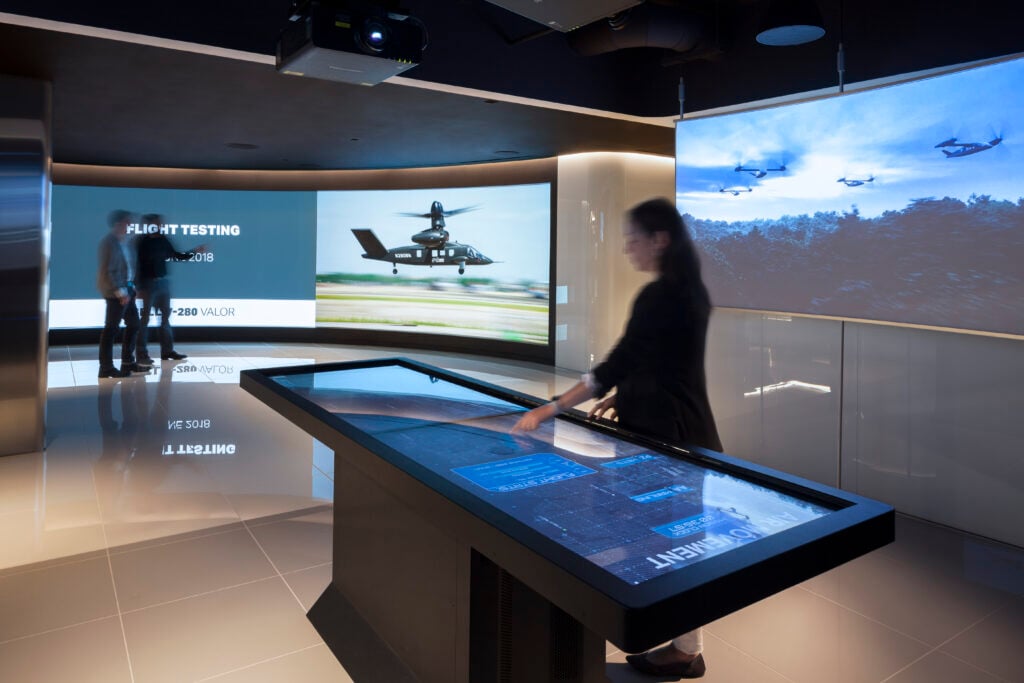
Bell’s Advanced Vertical Lift Center, just south of the Pentagon
One of those is the V-280 Valor, a new prototype tiltrotor the company built under the Defense Department’s Joint Multirole Technology Demonstrator project and has been flight testing for two years. The V-280 is a candidate to become the Future Long Range Assault Aircraft for the Army (and potentially the Marines and Special Ops as well). The other new product, still in concept stage, is the 360 Invictus, a 180-knot helicopter Bell is proposing as the Future Attack Reconnaissance Aircraft, the Army’s top aviation priority.
Visitors to Bell’s AVLC can see wall-size videos of V-280 flights. On a nearby waist-high “Mission Table,” they can watch multimedia depictions of combat scenarios featuring the V-280 and the Invictus, with music worthy of a Ridley Scott movie and narrated in person by combat veteran Col. (retired) Robert Freeland, a smooth-talking former Marine Corps CH-46 and V-22 pilot.
Down the hall — past the big 1/8-scale models on eye-level stands of the V-280 in Army and Marine configurations, the Invictus, and the V-247 Vigilant, a tiltrotor drone concept Bell has proposed for the Marines — they can fly a V-280 simulator with up-to-date flight control laws.
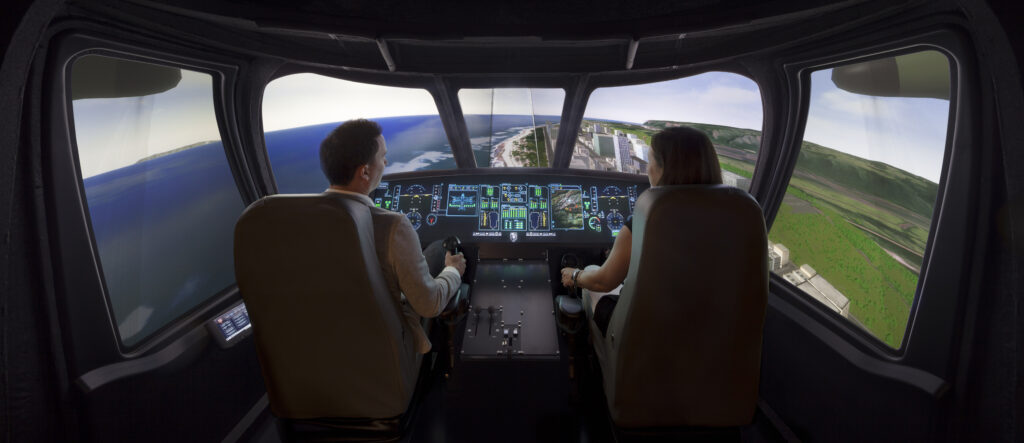
Flight simulator at Bell’s Advanced Vertical Lift Center
A little further, visitors can slip on an augmented reality headset that takes them inside the guts of a V-280, while a briefer explains how mechanics will be able to use such a device and “digital thread technology” to see “through” aircraft panels and innards while maintaining or repairing aircraft and getting help a la customer support if they need it.
There is also a 30-person capacity Secret-level conference room for classified briefings that government entities as well as Bell can use for classified discussions.
And AVLC invitees can attend catered receptions in sparkling entertainment rooms whose windows overlook the flood-lit Capitol Building, the Washington Monument and the capital’s airport, a spectacular scene as planes take off and land on a clear night.
“It’s in Crystal City, about one mile from the Pentagon and about two miles as the crow flies from Capitol Hill,” noted Schloesser. “All of the thought leaders such as yourself [flatterer — ed.], as well as all of the think tanks, are located fairly close as well, within about a three-mile range.
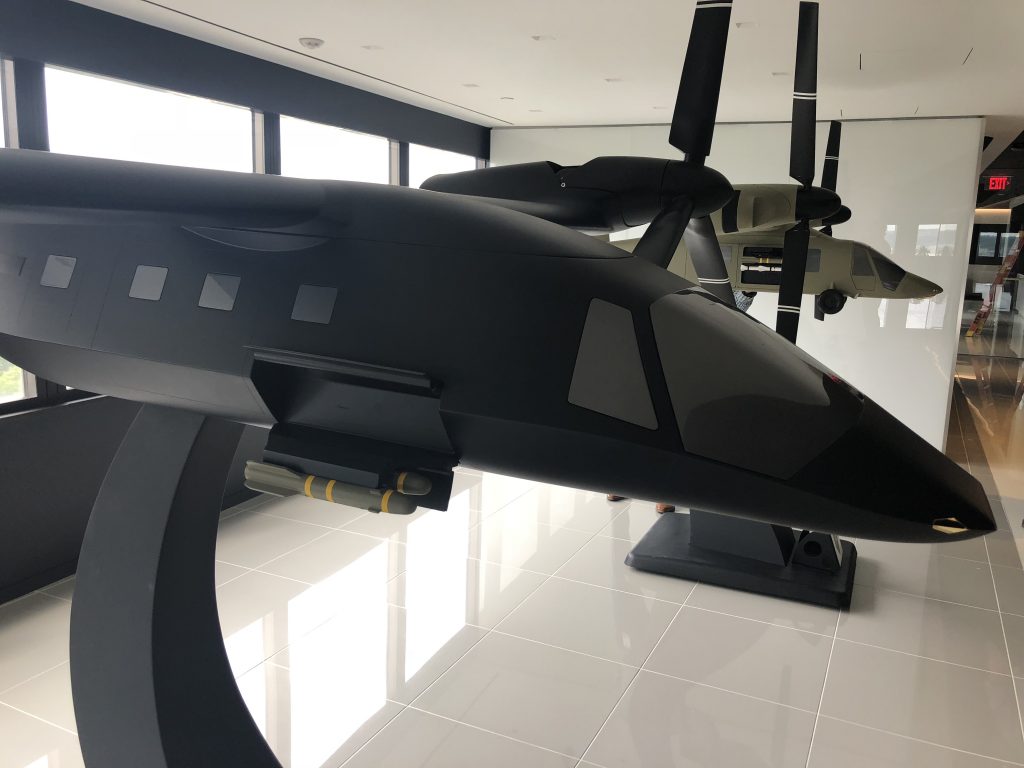
Bell’s proposed V-280 Valor attack variants, on display at the company’s Advanced Vertical Lift Center
“Think about that,” Schloesser emphasized. “What I just described is three separate audiences that most OEMs [Original Equipment Manufacturers for aircraft] or defense companies, are interested in. One, you have the customer base, which is in many cases the military, for the defense industry. You have the people that pay for it, which is the Hill, and their staffers are absolutely critical to that. Then you have all of the people that influence them, either through writing informative pieces like you do [there he goes again….] and doing video and things of that nature to actual think tanks that do longer-term studies.”

Jeffrey Schloesser
Aerospace and defense industry representatives assigned to get the government to buy their company’s products usually have job titles such as “Director, Business Development” or “Defense Customer Relations” because the military services have never liked the idea that they could be “sold” anything the way dealers sell cars. But it’s a fact that getting the government to buy a major military item like an aircraft is a lot less like a sale than a courtship.
Business development types, often military veterans themselves like Schloesser and Freeland, spend major amounts of time talking to military officers and relevant Defense Department civilian officials to understand the military’s needs, show them concepts or designs, and discuss how those can meet either their service’s existing needs or give them new capabilities. Based on such conversations, companies often adjust their designs, then talk to the “customer” about them again, hoping to ultimately reach an agreement, and thus a sale.
Traditionally, that process relied on a lot “shoe leather marketing”: traipsing through the halls of the Pentagon and visiting military bases with a briefcase full of slides or, in the computer age, a laptop loaded with PowerPoint. Good business developers still have an “elevator briefing” memorized so they can quick-pitch customer targets of opportunity they might happen to find themselves riding with in between floors of the Pentagon. That style of business development still goes on, but the digital age is changing it.
“I rarely am over in the Pentagon haunting those offices,” Schloesser said. “Instead, people ask to come here.”
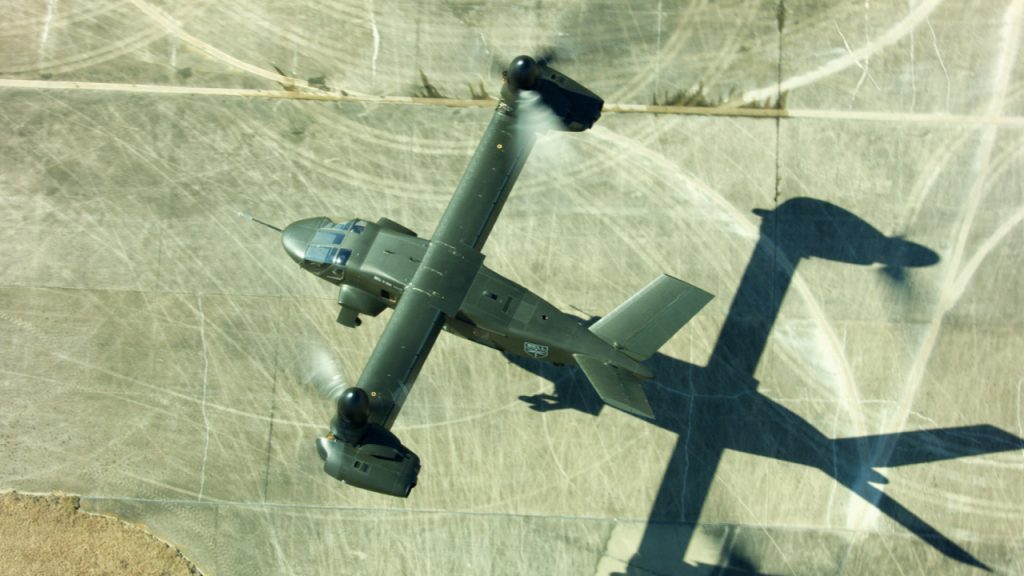
The real-life Bell V-280 in low-altitude maneuvers
In the 18 months the AVLC has been open, he said, “Most of the Army senior leadership has been here. Almost all of the Marine Corps senior leadership and aviation leadership has been here [as well as] the secretary of the Army and all those people that work in the acquisition and R&D process. And Hill staffers as well as the media.” More than 1,000 visitors were hosted there in the first year and a half of the AVLC’s existence, Schloesser said.
“These are not just cursory, ‘hey, welcome, let’s walk around,’ for ten minutes,” he said. “This is actually an hour at the least, two hours generally, and they’ll have hands-on experience and conversation about, ‘Now that you’ve seen this, what do you think? Where do you see the future going?’”
Schloesser sold Chief Executive Officer Scott Donnelly of Textron, Bell’s parent company, and Bell CEO Mitch Snyder on spending the considerable amount of cash it cost to open the AVLC when they hired him a couple of years ago. In a previous incarnation as a consultant, Schloesser spent about two years helping Bell engineers design the V-280, pointing out features the Army would want that differ from the V-22 Osprey, which was primarily designed for the Marines. Schloesser later ran the Washington office of Sierra Nevada Corporation, so when Bell recruited him to take charge of marketing the V-280, Schloesser had firm ideas about what needed to be done to develop business in Washington.
“If you do this the way that other people do that in this town, it tends to look like a K Street facility, where you’d be coming in here and it would be looking like a law firm,” Schloesser said. “We said, instead of doing that, let’s run a center where we can bring these customers, any of those three groups, over here and we can actually show them and they can actually do things hands-on – I’m a hands-on type of person – where they inform themselves. If it’s good enough that it’s exciting for them, then they get excited about it and then sometimes they go back to wherever they are, the Pentagon, the Hill, or back to K Street, or wherever they’re at, and they’re motivated to do the kinds of things that will help this series of programs go.”
Schloesser admits that the AVLC isn’t the defense industry’s first exhibition-style customer relations center. What might be the granddaddy of such facilities, at least in the DC area, is in a building right next door.
Defense conglomerate Lockheed Martin houses nearly 200 government operations staffers on the upper floors, but the first two floors are occupied by a Global Vision Center with a 180-seat auditorium, a Fighter Demonstration Center, a Space Experience Center, and a “collaborative space” where customers can help themselves to coffee and pastries while perusing a collection of company history artifacts and memorabilia. Those include items such as the original contract for delivery to Amelia Earhart of the Lockheed Model 10E Electra twin-engine airplane in which she and navigator Fred Noonan disappeared over the Pacific in 1937.
The Global Vision Center, which marked its tenth anniversary in September, took the place of an original, much smaller Fighter Demonstration Center down the street, said the global center’s director, Lynn Driscoll.
Visitors check in at a long guard desk flanked by an array of models of Lockheed Martin products ranging from F-16 Falcon fighter jets to the Freedom Class Littoral Combat Ship. As their tour begins, they usually see a video from a library of 70 the center has available.
“If we have an aero customer coming in, we try to tailor that content for aero customers, with the audio element as well as the video,” Driscoll said. “It’s just a subtle way of sending the message of, ‘We understand your business. This is the business we’re in also.’”
Today’s Fighter Demonstration Center includes a large room with a V-shaped table where senior military officers and civilian officials are briefed on the latest developments in the F-35 Joint Strike Fighter program. Then they can walk to another room to fly an F-35 simulator.
The Space Experience Center has an array of models of Lockheed satellites, which 20-year business development veteran and center director David Brandt talks about as he conducts guided tours. But the facility is being renovated to add sophistication.
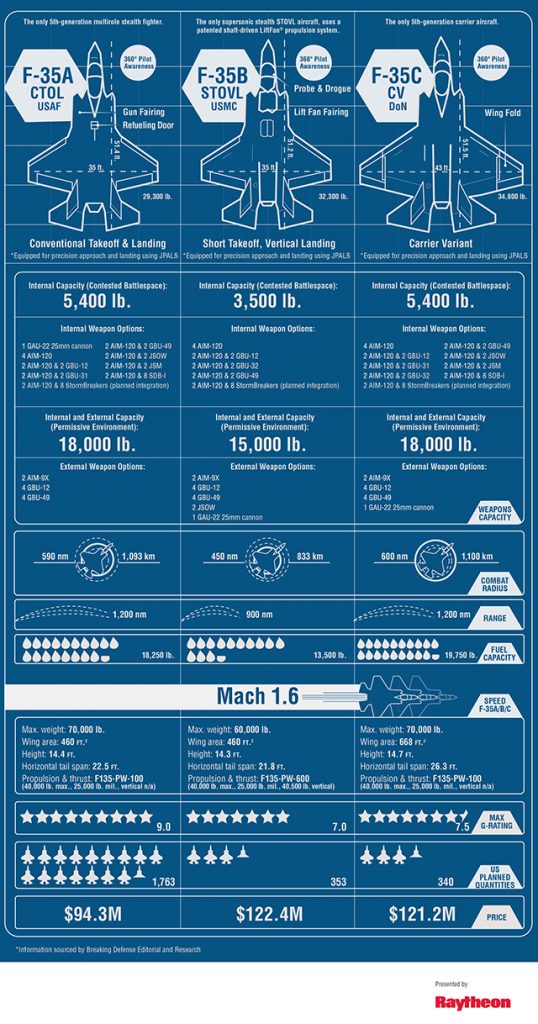 “Today is an example of the earlier iterations of the demonstration and exhibit centers,” Brandt said. “You can see a lot of exhibits and actual hardware. Whereas today we’re moving that into the digital era. So the new demonstration center we’re building out will have much more screenage, signage that’s digital, that can be changed on a moment’s notice, depending on who the customer is coming in. Also much more engagement and interaction.”
“Today is an example of the earlier iterations of the demonstration and exhibit centers,” Brandt said. “You can see a lot of exhibits and actual hardware. Whereas today we’re moving that into the digital era. So the new demonstration center we’re building out will have much more screenage, signage that’s digital, that can be changed on a moment’s notice, depending on who the customer is coming in. Also much more engagement and interaction.”
Lockheed Martin government affairs staffers still make plenty of calls at the Pentagon and on Capitol Hill. But Brandt said one advantage of inviting military and Pentagon officials or congressional members or staff to a facility such as his Space Experience Center is the chance to do “a deep dive technical interchange meeting that they can’t necessarily do in their facilities. Also, it works oftentimes just to get them away from the office for an hour, allow them to settle down a little bit more, and focus in on, again, the customer’s mission.”
Even after a satellite has been put into orbit, Brandt said, it’s important to keep selling it to those who have to keep funding it. “People think that in space we design, build, launch and go,” he said. “It’s really about, can we keep the Hubble space telescope running for 29 years? That’s the message that we’re trying to deliver, this value proposition.”
Schloesser said he was “aware of the Lockheed Martin facility” when he began developing Bell’s AVLC. “I thought it was state of the art at the time, and I wanted to go beyond that,” he said. “My inspiration came from our museums. If you go to some of our museums, either the Air and Space Museum, African American Museum, the Native American Museum, you go through experiences. It’s no longer the old museum experience where you have a dead thing on the wall and ‘oh by the way, that died 2,000 years ago.’” Those modern museums were “an inspiration, for sure, there’s no doubt about it,” he said.
Boeing declined my request to visit a room they use for customer briefings in a big Crystal City office they opened in 2014, but possibly there wouldn’t have been much to see. Schloesser said Boeing “chose to do other things with [their] facility. It’s more of an office space and a meeting center.” Bell’s AVLC, meanwhile, though just a year and a half old, is paying off, Schloesser said.
“What it has done is, allowed us to play a constructive role with the Army, the Marine Corps, and the Office of Secretary of Defense in deciding to accelerate the Future Long-Range Assault Aircraft program,” he said. “It was actually really not going to come to fruition for first unit equipped until about 2035. We showed them the realm of what is doable and now they want to accelerate by about four and a half years to five years, up to 2030 for first unit equipped.”
Schloesser also ventured that while others may still be engaging with customers the old-fashioned way, “I dare say that people are probably budgeting for something like this in the future.”
Airbus, UK agree $152 million deal for 6 H145 ‘overseas’ helicopters
The fleet of light-twin rotorcraft will replace Airbus Puma HC2 types, which have been temporarily based in Brunei for British Army training and the island of Cyprus in support of Royal Air Force search and rescue missions.


























